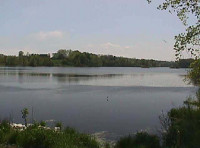Nonpoint Source TMDL Implementation

Silver Lake
Nonpoint source (NPS) pollution (or polluted runoff) continues to be a primary cause of water quality problems in Wisconsin. NPS pollution comes from many diffuse sources. It is caused by rainfall or snowmelt moving over and through the ground. As the runoff moves, it picks up and carries away natural and human-made pollutants, finally depositing them into rivers, lakes, wetlands, and groundwater. The state has numerous surface water bodies that are not meeting water quality standards and are considered to be "impaired" as a result of nonpoint source pollution impacts.
As required by the federal Clean Water Act, the DNR addresses waters impaired by nonpoint source pollution by establishing a "Total Maximum Daily Load" (TMDL). States are charged with ensuring the necessary actions are taken so that the loading of the pollutant of concern does not exceed the TMDL.
The goal of nonpoint source-related TMDL implementation is to maximize opportunities for restoration of impaired waters by prioritizing and targeting available programmatic, regulatory (such as the NR 151 agricultural performance standards and manure management prohibitions, financial (such as Targeted Runoff Management Grants) and technical resources.
TMDL implementation is an adaptive and holistic process, uniting point and nonpoint source pollution control in a watershed-based approach. Implementing plans to achieve TMDL targets for nonpoint source pollution is a challenging process that requires the collaboration of diverse stakeholders and a substantial commitment of public and private dollars.
To learn more about Wisconsin's efforts to control nonpoint source pollution, visit the Nonpoint page.
